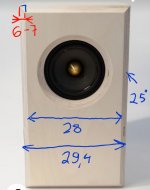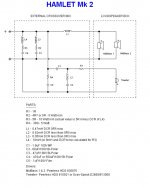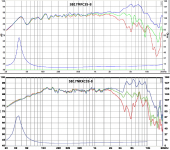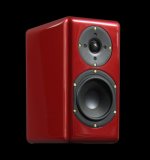Thanks Joe, appreciate your input on this. Will see if I can find something closer to 90mm.For 76mm ID, this may have something to do with as well. The length of 72mm may be a bit too long for that diameter. The extra 10-11mm greater ID can make a difference, especially as you say at very loud volume. I have found that with ID close to 90mm and length between 80-100mm should be enough and rarely should anybody ever hear chuffing.
Responding to the question about sensitivity, I am running my Elsinores, upgraded from Mk3 to Mk6, with the Elekit TU-8900 using 2A3 tubes. These are reportedly putting out 3.5 watts per side. They will not blast you out of the room (20x18x8 ft), but they will play much louder than I would be comfortable listening to, for any reason other than showing how loud it goes. And, even at full volume, there is no glare or sense that anything is stressed out. Quite remarkable. Not expected.
Joe, are the Hamlet designs finished yet? I do not see it on the Elsinore website, or is there a separate website for them?
Yes, they are finished. I haven't yet put them on the website yet, juggling a lot of things here, but hope to soon.
But the details were posted here on the forum, including available Xover PCB.
Take a look at links below that will take you backward in the thread.
Box Design - Link
Hamlet Crossover - Link
Please note the Xover does not come fully populated, it does come with three components including the 18mH inductor and 300uF Bi-Polar, as the word was designed for those difficult components.
Hope I have covered what you need above with those links, but go back and scroll forward and all the design details are there.
Not sure when it will show up on the website, maybe before or during the coming silly season.
Cheers, Joe
Last edited:
Thanks alanhuth, that helps a little. Based on my listening with my main system (active 110dB/w/m horns) I think that 50w of useful amplifier power should get the job done in my situation (105dB peaks). Any speaker I build will go into another room that is not well sealed and will not be so useful in terms of room gain and I may need to run subs in addition to the Elsinores...Joe has done such a good job getting the bass impedance peak so low that even if I run a high output impedance amplifier the Elsinore will only get to about 50Hz in room, perhaps 40Hz if I'm lucky.
hello joe, i would need your help again. I have finished my basic housing and planned to put the 18mm front panel on individually approx. 7mm wider and beveled at 25 °. The original 28mm dimension was retained on the front edge. At the rear edge of the 18mm front panel I would set it to 29.4mm. Would a correction of the frequency crossover be necessary for this? or is this still possible area? An example in the picture below. best regards Steff
Attachments
An update to Hamlets and another surprise.
I have been dollying up my own Elsinores which date back to Mk2 circa and hence need the old square fill-in for the waveguide. I will post photo some time soon, but what I used was Duratex roll-on textured finish.
Duratex Video
I have bought the MFC drivers for the Hamlets, they are here now. The new drivers will be fitted and the box will be given the Duratex treatment. Within a matter of weeks will be doing the computer modeling and get the crossover worked out. It will be the same crossover as I used with the earlier HDS drivers, but there is expected to be between 3-5 changes in values, the topology will be exactly the same.
Now for a little surprise, take a look at this photo:
An externally hosted image should be here but it was not working when we last tested it.
Dayton B452-AIR
Now as it is, it is cheap and great for a computer speaker. But I am going to take it much further and I will publish the details so that this will be a great little satellite speaker.
I will let you in on the first step that I have already done. The AMT tweeter is of course, the attraction here, but it uses a cheap (only so-so OK) polypropylene mid-bass driver... so we replace it with this:
An externally hosted image should be here but it was not working when we last tested it.
IMPORTANT: Must be the 8 Ohm version as shown - Dayton PC105-8
Just replace with this much better driver, BUT it is not a straight fit, you will need to file away not quite a millimeter where the four holes are, as it is a slightly larger driver. The existing mounting holes are just fine.
Later, we shall develop this into something more advanced and take advantage of the drivers that are now both of them good, and not just the AMT tweeter.
Use it like that for now, it is amazing value and we shall make it better still after I have done some measurements etc.
4" FULL RANGE POLY CONE DRIVER - DAYTON AUDIO
SMOOTH RESPONSE WITH TRUE FULL-RANGE REPRODUCTION
Dayton Audio’s PC105 4” full-range driver will deliver smooth and natural response from extremely compact designs. When used in line arrays, portable speakers, sound bars, or as a dedicated midrange in 3-way designs this driver will prove to be an excellent value.
Poly damped woven glass fibre cone controls cone break-up and provides a smooth roll-off
Copper cap keeps inductance under control and extends high frequency response
1" vented aluminium voice coil former and vented pole piece for high power handling
High energy ferrite magnet increases BL for higher efficiency and more output
Smooth response with true full-range reproduction for simple speaker designs.
Hey Joe!
Not sure if you remember, but last December you helped me via email a number of times building these fantastic speakers - I ended up building a pair of Mark V towers and a corresponding second generation Hamlet. I have to say these speakers still impress me every time I use them - the amount tightly controlled low end bass these things put out has left me without needing or wanting a sub in my home theatre setup - which is very good news considering the neighbors in my apartment building! Thank you so much for all of your hard work and dedication to this project. I'm soon going to update my xovers with the Audyn high pass caps from the Jantzen superior zcaps as well which I'm excited about..
I also am using the quoted upgraded Dayton speakers as the rear satellites - I was wondering if you had ever had a chance to have a look at further improvements to these? They work great in my setup for the surrounds but further mods would make a fun project
Anyways thanks again!
FYI to people reading - this is concerning the version of the Hamlet before the recent one, which was originally intended to pair with the Mark IV or V Elsinores I believe..
Sorry, a couple other questions re: the Mark II Hamlets..
The original posted xover schematic had the tweeter high pass after the RC networks of the low pass filters... which is how I connected it... I have noted that it seems like sometimes the voices seem a little muffled... not certain whether this would potentially be the cause? Also, I used a solen air core inductor for the 0.47mh inductor rather than a corresponding Jantzen copper foil inductor similar to those suggested for the elsinore xovers.. not sure if this would've affected the speaker sensitivity, as the Jantzens are listed as allowing for high current capability? Maybe this would be important as the mids on the Hamlet V2s are connected in parallel?
Solen Electronique Inc. | L14.47
Jantzen Audio 0.47mH 16 AWG Copper Foil Wax Coil Crossover Coil
Sorry, a couple other questions re: the Mark II Hamlets..
The original posted xover schematic had the tweeter high pass after the RC networks of the low pass filters... which is how I connected it... I have noted that it seems like sometimes the voices seem a little muffled... not certain whether this would potentially be the cause? Also, I used a solen air core inductor for the 0.47mh inductor rather than a corresponding Jantzen copper foil inductor similar to those suggested for the elsinore xovers.. not sure if this would've affected the speaker sensitivity, as the Jantzens are listed as allowing for high current capability? Maybe this would be important as the mids on the Hamlet V2s are connected in parallel?
Solen Electronique Inc. | L14.47
Jantzen Audio 0.47mH 16 AWG Copper Foil Wax Coil Crossover Coil
Attachments
FYI to people reading - this is concerning the version of the Hamlet before the recent one, which was originally intended to pair with the Mark IV or V Elsinores I believe..
Sorry, a couple other questions re: the Mark II Hamlets..
The original posted xover schematic had the tweeter high pass after the RC networks of the low pass filters... which is how I connected it... I have noted that it seems like sometimes the voices seem a little muffled... not certain whether this would potentially be the cause? Also, I used a solen air core inductor for the 0.47mh inductor rather than a corresponding Jantzen copper foil inductor similar to those suggested for the elsinore xovers.. not sure if this would've affected the speaker sensitivity, as the Jantzens are listed as allowing for high current capability? Maybe this would be important as the mids on the Hamlet V2s are connected in parallel?
Solen Electronique Inc. | L14.47
Jantzen Audio 0.47mH 16 AWG Copper Foil Wax Coil Crossover Coil
So I spent a bit of time trying to figure this out yesterday - I think it may be that in my HT setup, the receiver has a sound equalization program I used to normalize the volumes between the speakers in my 5 surround/4 ceiling speaker Dolby Atmos setup.. As a result the center speaker (Hamlet) was set at a lower volume than the towers - however I think the perceived lower volume at sitting position may reflect the off axis performance maybe? When I moved my head from my slightly off axis seated position to directly in line with the speaker with a test tone playing, the perceived sound volume increases a bit - I wonder if the microphone for the equalizer since it is more directly in line with the front of the speaker perceives a higher relative output level (and adjusts the volume down) than I do at my typical off axis position (and thus I need to set the volume higher than that determined by the microphone)..
Hi again,
I made a basic mistake in my previous post (4ohms instead of 8ohms ! ) and asked for deletion.
) and asked for deletion.
---
I am new here and very interested in building the Elsinor.
(my current speakers are Kef R900 with crossover upgrade. See Rxx mesurements here and here : not bad...).
Regarding the differences between the NRXC and the later MFC.
- One can see two major differences between the MFC and NRXC respons curves : 30to60Hz and 3to10kHz. (And a smaller one from 100to250Hz).
>>> Some values of the crossover were changed.- Qts and Vas are not the same, was the case (+port length) changed ?
sb17nrxc35-8/ : Qts 0.34, Vas 44.5 l
sb17mfc35-8/ : Qts 0.37, Vas 39 l
Thanks a lot to Joe for the fabulous work and sharing.
Ed
I made a basic mistake in my previous post (4ohms instead of 8ohms !
---
I am new here and very interested in building the Elsinor.
(my current speakers are Kef R900 with crossover upgrade. See Rxx mesurements here and here : not bad...).
Regarding the differences between the NRXC and the later MFC.
- One can see two major differences between the MFC and NRXC respons curves : 30to60Hz and 3to10kHz. (And a smaller one from 100to250Hz).
>>> Some values of the crossover were changed.- Qts and Vas are not the same, was the case (+port length) changed ?
sb17nrxc35-8/ : Qts 0.34, Vas 44.5 l
sb17mfc35-8/ : Qts 0.37, Vas 39 l
Thanks a lot to Joe for the fabulous work and sharing.
Ed
Attachments
I am thinking about doing a version of the Elsinores using Purifi drivers.
They have brought out a 6.5" driver that has standard peak-to-peak excursion (12mm versus 19mm) and that means the sensitivity is higher and now seems to be on par with the SB17MFC driver.
If you buy eight at a time, their website says that they are DKK (Kroner) 1882 each and eight is the total is a tad over 15 thousand Kroner. You can look up Currency Exchange Rates - International Money Transfer | Xe and find out what that is in your currency. Since each driver is 2Kg, the total shipping weight must be around 20Kg.
No loudspeaker name or version number yet. I need to contact Purifi first and take it from there. I don't think they have seen any project that uses eight of their drivers, so their interest might be piqued by that. Also, many of the thoughts behind the Elsinores line up with their ideas and the technologies they have used as solutions, such as excursion and surround issues (low excursion in the Elsinores suppress those problems along with high sensitivity etc).
This is not yet a promise, but that new driver has made it a possibility. It will be a very expensive thing to do it DIY. Maybe close to the most expensive DIY speaker on the internet?
This is the driver PTT6.5-NF8:


The box will be identical, but the holes and rebating of the driver will be different. The tuning using the port may also need to be tweaked, the port may need to be a bit shorter, perhaps 60mm. It may fall ever so short of bass extension compared to SB17MFC, but that may not even be noticeable.
Can anybody here afford this?
If the answer is no, then don't lose any sleep over it. I may still build this just to further my own education. I have built other designs not mentioned here, but I have learned things from doing them - and this may well be a bit like that - except I have to find the money to do it (working on that). This will be very expensive!
They have brought out a 6.5" driver that has standard peak-to-peak excursion (12mm versus 19mm) and that means the sensitivity is higher and now seems to be on par with the SB17MFC driver.
If you buy eight at a time, their website says that they are DKK (Kroner) 1882 each and eight is the total is a tad over 15 thousand Kroner. You can look up Currency Exchange Rates - International Money Transfer | Xe and find out what that is in your currency. Since each driver is 2Kg, the total shipping weight must be around 20Kg.
No loudspeaker name or version number yet. I need to contact Purifi first and take it from there. I don't think they have seen any project that uses eight of their drivers, so their interest might be piqued by that. Also, many of the thoughts behind the Elsinores line up with their ideas and the technologies they have used as solutions, such as excursion and surround issues (low excursion in the Elsinores suppress those problems along with high sensitivity etc).
This is not yet a promise, but that new driver has made it a possibility. It will be a very expensive thing to do it DIY. Maybe close to the most expensive DIY speaker on the internet?
This is the driver PTT6.5-NF8:


The box will be identical, but the holes and rebating of the driver will be different. The tuning using the port may also need to be tweaked, the port may need to be a bit shorter, perhaps 60mm. It may fall ever so short of bass extension compared to SB17MFC, but that may not even be noticeable.
Can anybody here afford this?
If the answer is no, then don't lose any sleep over it. I may still build this just to further my own education. I have built other designs not mentioned here, but I have learned things from doing them - and this may well be a bit like that - except I have to find the money to do it (working on that). This will be very expensive!
Very keen to see a Purifi version. Hope a better tweeter can be incorporated. Having a loudspeaker with the best performing drivers available is surely something to aspire to -look at this beast shame a cabinet pre done like these wasn't available SB Acoustics SASANDU DIY Speaker Kit - Fidelity Components Shop
I bought the lumber, and started cutting the boards for my Hamlet center this afternoon. I went with HDF panel boards like I did with my Elsinore's for two reasons, by laminating them together I get the correct thicknesses, and it's so much easier to work with if your by yourself. Not to mention, it's true HDF, maybe even better since I'm laminating panels together. I'll take pictures when I have something to take a picture of...I just ripped two pieces.
Another thing to factor in if you haven't considered it is that once the amount is above $1000 on an import you get charged GST and Customs taxes by the couriers before it gets delivered to you in Australia.This will be very expensive!
I forgot this when I ordered a Purifi Amp board and it ended up costing me about 20% more than I had first thought. Purifi's shipping is also quite expensive in general to Australia.
Just an FYI if you haven't already considered this
This is the driver PTT6.5-NF8:[/QUOTE said:On Madisound, it's $369 ea, that would make 8= $2952....all I can say is this...that would be an awesome upgrade. I would not hesitate to upgrade..if I have that kind of money for an upgrade for a speaker that already sounds beyond incredible.
Very keen to see a Purifi version. Hope a better tweeter can be incorporated... [/url]
Let me say something, and this is from a guy who makes arguably the best electrostatic speakers in the world by rebuilding Martin-Logan speakers with mylar that is 1/3rd the thickness than anybody is willing to try, and he says the tweeter as used in the Elsinore, with that waveguide and that crossover, has such low distortion that it matches the best electrostatics!
No kidding!
So no, I cannot see myself changing that tweeter for any other. Besides, try to find tweeters that suits waveguides, try to find tweeters with rated sensitivity well over 90dB and not rated 4 Ohm (this is rated a genuine 8 Ohm) and you find that there are not that many tweeters around that are any good for the job at hand. This tweeter also had the influence in its design by Russell Storey who I consider a friend (in fact I just got of the phone) and it's a miracle that tweeter even got made and maybe even bigger miracle that we can still get it. The politics behind the scene almost killed it and the fact that I got people like Michael Lenehan and other designers to use it in the commercial speakers, made sure that it is still made. Maybe without my activism behind the scenes, this tweeter would have been killed off. They don't make as much money making them as their more expensive tweeters, so it is only demand that kept them to continue making them.
One designer told me that it is one of the best two genuine 1" tweeters in the world. OK, that was a couple of years ago, but it is still right up there and the other was many times its price.
Attachments
That looks to be about $2400 for just the woofers. Pretty expensive endeavor. The appealing aspect of the Elsinore's to me is the performance/price.
It would have to be a really large improvement to justify that. That is about a $1800 difference between the woofer choices.
I am very excited to hear your listening impressions!
It would have to be a really large improvement to justify that. That is about a $1800 difference between the woofer choices.
I am very excited to hear your listening impressions!
"Diminishing returns" at that price point, I doubt the return on the investment, would even come close to what the Elsinores are. If this is a drop in replacement upgrade, with minor changes to the xover, then any upgrade I am for! But this is an upgrade I will not by able to make myself!
TW29BN-B-8 93.5 db and it sounds bloody awesome !
TW29BN-B-8 Satori 11/4" Dome Tweeter Beryllium Neo, Speaker Drivers | Wagner Online Electronic Stores
I realise you have gone to the trouble of the waveguide etc and that makes it extra work but they actually have a waveguide version as well Satori 11/4" Dome Tweeter Beryllium Neo With 170Mm Wave | Wagner Online Electronic Stores
-sorry the Lenehan tweeter did nothing for me
TW29BN-B-8 Satori 11/4" Dome Tweeter Beryllium Neo, Speaker Drivers | Wagner Online Electronic Stores
I realise you have gone to the trouble of the waveguide etc and that makes it extra work but they actually have a waveguide version as well Satori 11/4" Dome Tweeter Beryllium Neo With 170Mm Wave | Wagner Online Electronic Stores
-sorry the Lenehan tweeter did nothing for me
Last edited:
- Home
- Loudspeakers
- Multi-Way
- The "Elsinore Project" Thread



